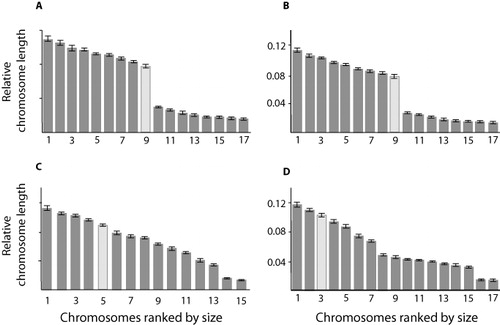Figures & data


Table 1 Average relative length of each chromosome in the karyotype of Hawkes Bay male Hemideina thoracica (n = 10), and the average ratio for arm lengths (q/p) provides centromere position, and nomenclature based on Levan et al. (Citation1964). Metacentric (m 1.05–1.66); submetacentric (sm 1.67–2.99); subtelocentric (st 3.00–6.99); telocentric (t 7.00–39.00). The P-value used to assign chromosome pairs was taken from two-sample t-tests for differences between chromosomes.
Table 2 Average relative length of each chromosome in the karyotype of Manawatu male Hemideina thoracica (n = 10), and the average ratio for arm lengths (q/p) provides centromere position, and nomenclature based on Levan et al. (Citation1964). Metacentric (m 1.05–1.66); submetacentric (sm 1.67–2.99); subtelocentirc (st 3.00–6.99); telocentric (t 7.00–39.00). The P-value used to assign chromosome pairs was taken from two-sample t-tests for differences between chromosomes.
Table 3 Average relative length of each chromosome in the karyotype of Manawatu male Hemideina crassidens (n = 10), and the average ratio for arm lengths (q/p) provides centromere position, and nomenclature based on Levan et al. (Citation1964). Metacentric (m 1.05–1.66); submetacentric (sm 1.67–2.99); subtelocentirc (st = 3.00–6.99); telocentric (t 7.00–39.00). The P-value used to assign chromosome pairs was taken from two-sample t-tests for differences between chromosomes.

